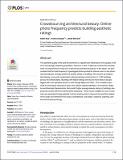| dc.contributor.author | Bernard, James | |
| dc.contributor.author | Saiz, Albert | |
| dc.contributor.author | Salazar Miranda, Ariana | |
| dc.date.accessioned | 2019-01-31T16:44:31Z | |
| dc.date.available | 2019-01-31T16:44:31Z | |
| dc.date.issued | 2018-07 | |
| dc.date.submitted | 2017-04 | |
| dc.identifier.issn | 1932-6203 | |
| dc.identifier.uri | http://hdl.handle.net/1721.1/120159 | |
| dc.description.abstract | This is an open access article distributed under the terms of the Creative Commons Attribution License, which permits unrestricted use, distribution, and reproduction in any medium, provided the original author and source are credited. The aesthetic quality of the built environment is of paramount importance to the quality of life of an increasingly urbanizing population. However, a lack of data has hindered the development of comprehensive measures of perceived architectural beauty. In this paper, we demonstrate that the local frequency of geotagged photos posted by internet users in two photo-sharing websites strongly predict the beauty ratings of buildings. We conduct an independent beauty survey with respondents rating proprietary stock photos of 1,000 buildings across the United States. Buildings with higher ratings were found more likely to be geotagged with user-uploaded photos in both Google Maps and Flickr. This correlation also holds for the beauty rankings of raters who seldom upload materials to the internet. Objective architectural characteristics that predict higher average beauty ratings of buildings also positively covary with their internet photo frequency. These results validate the use of localized user-generated image uploads in photo-sharing sites to measure the aesthetic appeal of the urban environment in the study of architecture, real estate, urbanism, planning, and environmental psychology. | en_US |
| dc.publisher | Public Library of Science | en_US |
| dc.relation.isversionof | http://dx.doi.org/10.1371/journal.pone.0194369 | en_US |
| dc.rights | Creative Commons Attribution 4.0 International license | en_US |
| dc.rights.uri | https://creativecommons.org/licenses/by/4.0/ | en_US |
| dc.source | PLoS | en_US |
| dc.title | Crowdsourcing architectural beauty: Online photo frequency predicts building aesthetic ratings | en_US |
| dc.type | Article | en_US |
| dc.identifier.citation | Saiz, Albert et al. “Crowdsourcing Architectural Beauty: Online Photo Frequency Predicts Building Aesthetic Ratings.” Edited by Tobias Preis. PLOS ONE 13, 7 (July 2018): e0194369 © 2018 Saiz et al | en_US |
| dc.contributor.department | Massachusetts Institute of Technology. Department of Urban Studies and Planning | en_US |
| dc.contributor.mitauthor | Saiz, Albert | |
| dc.contributor.mitauthor | Salazar Miranda, Ariana | |
| dc.relation.journal | PLOS ONE | en_US |
| dc.eprint.version | Final published version | en_US |
| dc.type.uri | http://purl.org/eprint/type/JournalArticle | en_US |
| eprint.status | http://purl.org/eprint/status/PeerReviewed | en_US |
| dc.date.updated | 2019-01-22T18:33:41Z | |
| dspace.orderedauthors | Saiz, Albert; Salazar, Arianna; Bernard, James | en_US |
| dspace.embargo.terms | N | en_US |
| dc.identifier.orcid | https://orcid.org/0000-0003-4407-4661 | |
| dc.identifier.orcid | https://orcid.org/0000-0003-4093-9250 | |
| mit.license | PUBLISHER_CC | en_US |
